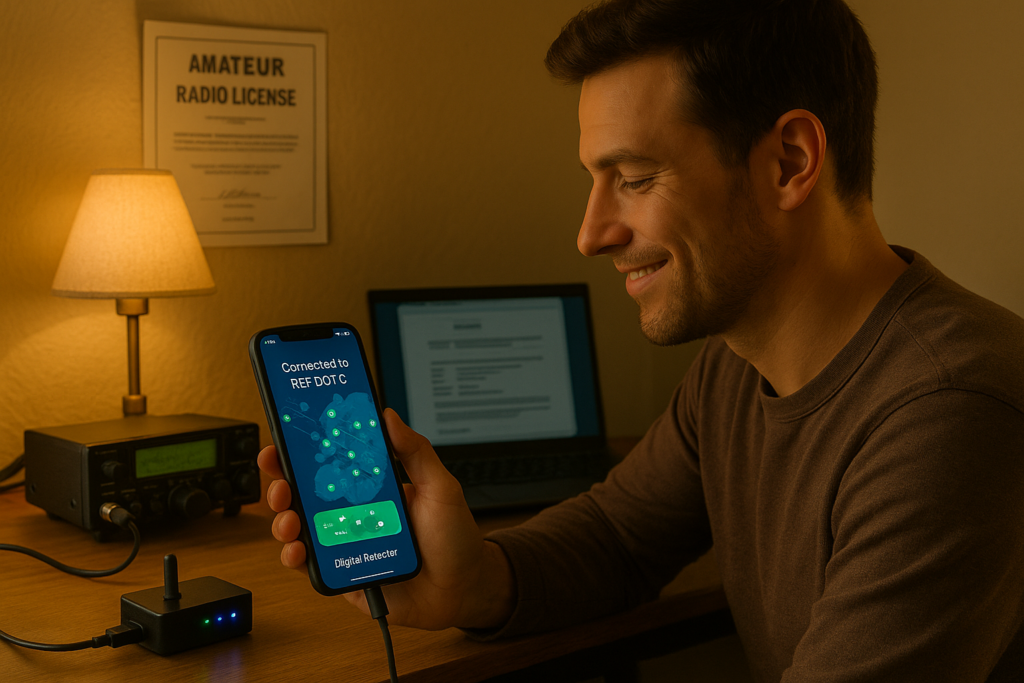Convierte tu móvil en un verdadero “walkie-talkie” global
Advertisements
Amateur radio waves travel across entire continents, and with just your cell phone and a few taps, you can join that chain of voices: listen to stations from another hemisphere, participate in emergency patrols, or say hello to a friend testing his homemade antenna on the nearest mountain. All this without risking sanctions, because the band filter blocks any prohibited police or aeronautical ranges.
Install EchoLink, Droid-Star, or RepeaterBook, validate your callsign, and configure them step-by-step in just one week. Upon completion, you'll have propagation alerts, instant access to digital reflectors, and a personal protocol that prevents transmission outside the amateur radio bands, keeping your hobby within the law and your audio impeccable.
Advertisements
An amateur radio app is powerful: it connects your phone to remote repeaters, digital reflectors, and bridge stations without buying a transceiver or antenna. But, if configured incorrectly, it can overload servers, generate annoying over-modulation, or—in the worst case scenario—accidentally transmit in ranges reserved for police.
The "7x7 Mobile Radio" plan below establishes a gentle learning curve: each day adds a critical adjustment, an on-air practice, and a safety check. Upon completion, you'll manage analog and digital QSOs, know how to link to emergency networks, and have the peace of mind of operating 100% within regulations.
Advertisements
See also
- More vitality with a tea that wakes you up without overdoing it
- The Expense Killer: The App to Cancel Hidden Subscriptions
- The AI Summarizer That Gives You Elite Knowledge in 5 Minutes
- The Time Machine for your Financial Planning
- The Secret Mirror to Analyze Voice and Project Power
“7×7 Mobile Radio” Plan
Day 1 — License verification and first scan
- Download EchoLink, upload a photo of your certificate, and wait for approval (it usually takes hours, not days).
- After validation, connect to the EchoTest node and speak for ten seconds; you'll hear your own audio returned. Adjust the volume until distortion is eliminated.
- Create a “QSO Log” document to record the date, time, and node of each test.
Day 2 — First digital link on Droid-Star
- Enter your callsign in Settings, select D-Star XLX999 reflector module C (test room).
- Send a brief greeting (“This is LU1ABC on audio test”). Listen for a response or monitor the reflector log to see your call.
- Activate the band filter in Preferences: the app will hide any server outside the amateur service.
Day 3 — Mapping repeaters with RepeaterBook
- Download the offline database for your province or state. Select the nearest VHF and UHF repeaters.
- Write down the transmission frequency, offset, and CTCSS tone; this will help you program future laptops or hotspots.
- Remove any repeaters labeled “public service” or “restricted use” from the list.
Day 4 — Creating a portable Wi-Fi hotspot
- Use an MMDVM dongle or a Pi-Star if you have one; configure BrandMeister with your DMR ID.
- Connect your smartphone to the hotspot and test a local TG.
- Check your BrandMeister dashboard to make sure the broadcast is showing your correct callsign.
Day 5 — Good Audio Practices and Etiquette
- Adjust compression: In the EchoLink menu, lower Mic Gain if your signal appears clipped (>3 dB).
- Practice identification every ten minutes; set a reminder in the app itself.
- Join an evening chat network and participate with short messages so you don't monopolize time.
Day 6 — Emergency Simulation
- In Droid-Star, connect to an emergency test TG and send the report “All Clear.”
- Check battery consumption: measure how much it consumes during 30 minutes of continuous listening and activate background power saving.
- Prepare a predefined message with your location in latitude/longitude for future real-life emergencies.
Day 7 — Final audit and publication of results
- Review your QSO log and confirm that you included your callsign, band, and mode for each day.
- Run a port scan on your home network: Block any foreign access to the EchoLink port.
- Share your experience, final configuration, and steps to avoid interfering with critical services on an amateur radio forum; you'll receive feedback that will help you further refine your mobile station.

Precautions and continued good practices
- Keep your hotspot apps and firmware up to date; new codecs or patches address security flaws.
- Never transmit card numbers, access codes, or private coordinates; amateur radio is public by definition.
- Avoid encrypted modes: they are prohibited in most amateur rulesets.
- Use headphones with a microphone to reduce echo and protect privacy in public places.
- If you're traveling, check your destination country's band plan; allocations may vary slightly.
Help the community without crossing the line
Report any attempt by the app to list frequencies outside of its assigned range to the developers; you'll help keep the spectrum clean and reinforce the image of the conscientious amateur radio operator. Invite new operators to follow this same seven-day plan to grow their hobby legally and responsibly.
You may also be interested in